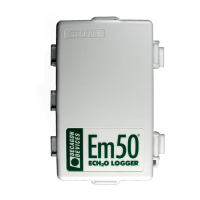27
EM50
6. EM50R RADIO TELEMETRY
This section gives you a brief overview of the radio telemetry available in the ECH
2
O system.
This information only applies to Em50R. The ECH
2
O system supports two types of radio
telemetry: "two-way" mode and "Transmit" mode. Consider one or both types of radio modes
when designing your ECH
2
O telemetry system. The "Confirm Delivery Transmit" mode ensures
the most complete data transfer and the best battery life. However, there are some unique
cases where you may want to use the other available modes.
NOTE: You need either a DataStation or an Rm-1 to utilize the radio communication capabilities of the Em50R.
ECH
2
O telemetry networks require each remote radio logger to have a unique name. Each
logger leaves the factory with the name set to the logger unique serial number. You can easily
change the name of the logger to help you identify or organize your data. You should not give
two loggers the same name. Two loggers with the same name interfere with each other when
communicating over the radio.
6.1 TRANSMIT RADIO TELEMETRY
The Transmit Radio mode helps you create a simple network of remote radio loggers all
transmitting data to a DataStation radio base station. The DataStation stores data from
all the remote loggers in one convenient place. Typically, you connect a DataStation to your
computer where you can easily download the data for use in DataTrac3. Unlike the two-way
Radio modes, you cannot remotely change logger settings when using this mode.
When a logger is in Transmit mode, it only turns on the radio when it has new data to
broadcast. For example, when you set the measurement interval in your logger to 60 min, the
logger stores your data every hour and then broadcasts the data to a listening DataStation.
The actual transmit time is randomly delayed for several minutes to prevent two or more
radio loggers from interfering with each other.
The Transmit radio modes use less battery power because the radio is off most of the time.
The Em50R is designed to work approximately 12 months in Transmit mode.
NOTE: A DataStation is a receiver. It does not cause the remote logger to send data. If your DataStation is powered
off for some time, it does not receive data sent by the remote loggers. However, the logger stores the missing data
fordownload.
6.1.1 TRANSMIT RADIO MODES
Use the Configure button in the Communication Hardware options to choose one of the
following radio modes that support Transmit communication.
Confirmed Delivery Transmit:This is the recommended mode since it is the most robust
Transmit radio mode. The radio logger adds a checksum to the data packet before
broadcasting the data to a DataStation. The logger then waits for the DataStation to
confirm it correctly received the data packet. If the logger does not hear the confirmation, it
retries sending the packet again. The logger stops trying to transmit to a DataStation after
25 attempts.

